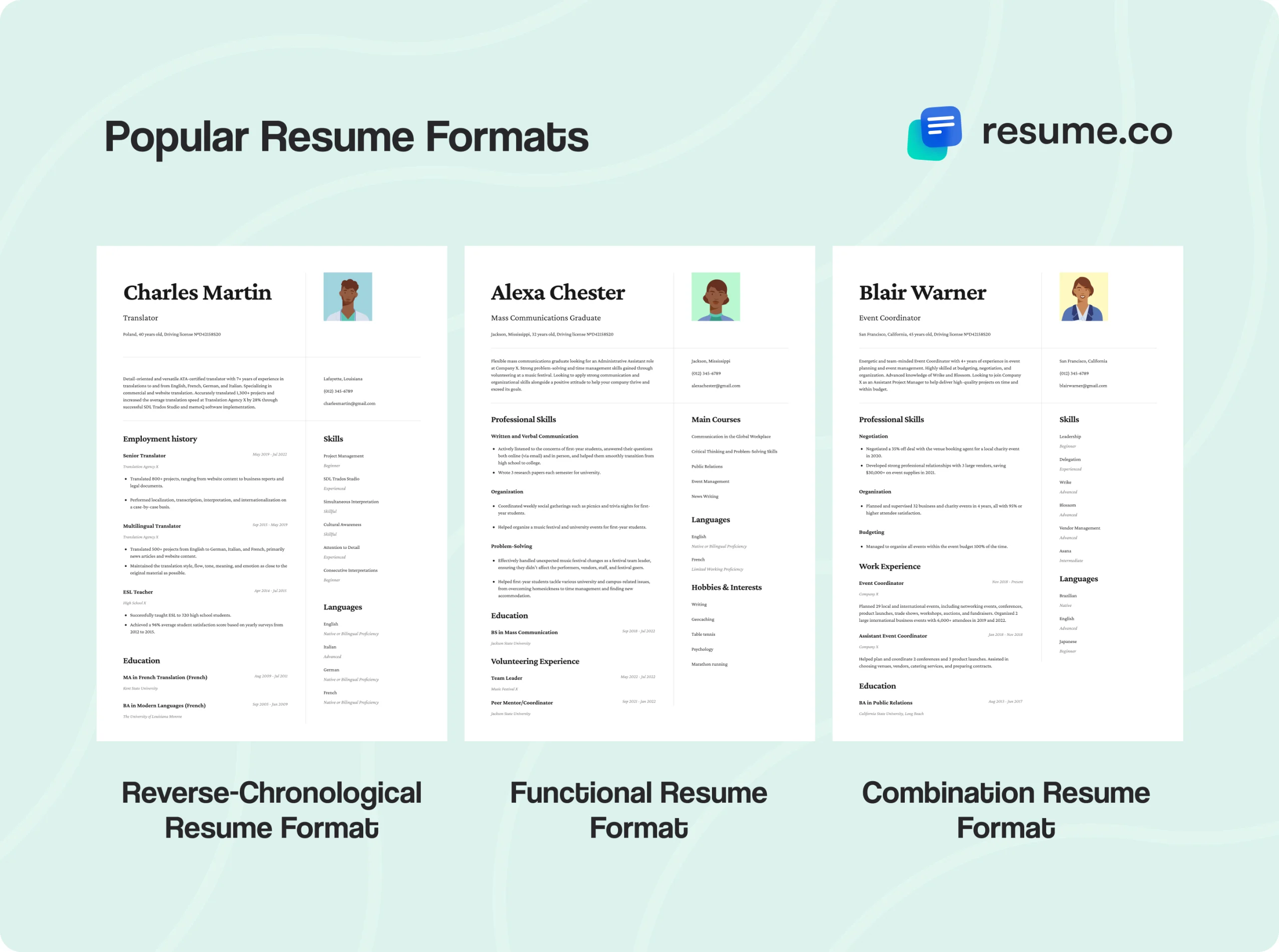To create a compelling CV that will impress a recruiter, you need to make every single part of it impeccable. This might sound like an enormous struggle, but with the right CV tips and tricks, you can craft a flawless one without any issues.
With that in mind, we’ve compiled a comprehensive list of 25 dos and don’ts to help you learn how to write a CV without hassle!
Key Takeaways
You have just a few seconds to make a recruiter keep reading your CV to its very end. To achieve that, there are a few tips to follow.
Make sure that your CV isn’t messy and unintelligible. Pay attention to the format and use a professional-looking font.
Double-check the contact information you’ve listed for typos and unnecessary personal details.
Keep your CV within one page. You can do so even if you have a rich professional background by including only previous jobs and skills relevant to the role you’re applying for.
Don’t use clichéd buzzwords or, even worse, lie in your CV in order to impress a recruiter, as you will only be rejected.
Top 25 Best Tips & Tricks to Make Your CV Stand Out

A recruiter spends an average of 5-7 seconds reading a CV. In such little time, they decide to either throw it straight in the bin or invite you to an interview.
For the latter to happen, you’ll need a compelling one, so here are some handy tips and tricks to help you make it:
#1. Format Your CV the Right Way
The first thing a recruiter will notice is how your CV is formatted. If it’s all jumbled and cramped with text typed in a fancy but unintelligible font, they will just discard it and move on to the next one.
So, to create a professional CV format, you need to structure it adequately. Here’s how to do it:
General CV Format
Use a simple font that is easy to read.
Set the font size to 10–12 pt.
Add headings for each section.
Bold subheadings to further divide sections.
Add space between sections.
Use bullet points to avoid large chunks of text.
#2. List Your Contact Information
Your contact information is the first section of your CV, and it doesn’t leave any room for mistakes. After all, would there be much point in sending your CV if a hiring professional couldn’t reach out to you?
This part should contain:
Mandatory Details
Your full name
Professional email
Phone number
Location
LinkedIn profile or website
Double-check all the information you’ve listed. You need to pay close attention to every detail; if you make even the slightest typo, a recruiter won’t be able to get in touch with you. As a consequence, you’ll lose your chance of landing a job.
#3. Add the Skills Wisely
When adding your skills, list only those that are relevant to the position you’re applying for. Adding all the skills that you have isn’t a good call and won’t yield any good results.
To be positive about what skills to include, check out the specific job advertisement you are interested in to find the skills the employer looks for in a candidate. Pay attention to both hard and soft skills, as well as transferable skills.
Though current hiring trends favor soft over hard skills, don’t ignore the latter completely, either. They are a good indicator of whether you’re knowledgeable enough to do the everyday tasks that the position requires.
#4. Omit Personal Details
Including your personal details is usually unnecessary when submitting a CV; contact information is the only exception.
Thus, you should avoid mentioning the following:
Omit Personal Details
Gender identity
Date and place of birth
Date of graduation
Marital status
Sexual orientation
Religious beliefs
Political affiliation
Social security number
Passport or ID number
These details don’t belong to a CV, and listing them won’t earn you bonus points for effort. On the contrary, it may lead to discrimination against age, race, ethnicity, etc.
#5. Include a Professional Email Address
Always make sure that your email is professional enough. Ideally, it should include your full name; alternatively, you can combine it with initials, figures, underscores, or dots if your name is common.
Resist the urge to be creative and humorous or give a hint that you’re a bit edgy. Not a single hiring professional will consider you serious and invite you for an interview if they see something like flying.monkey@gmail.com or badboy666@gmail.com in your CV. What’s more, even 76% of CVs are simply ignored because of an unprofessional email.
#6. Specify Your Work Experience
Simply listing your previous roles in your CV is not sufficient; you need to be a bit more specific. In addition to the positions and the amount of time you spent in them, your professional work experience section should include:
Specify Your Work Experience
Your achievements. These would be the accomplishments you made to help your previous company grow.
Facts and figures. Support your achievements with specific data, numbers, and percentages instead of just listing them.
Action. This includes the steps you took to obtain the positive results.
Timeframe. It represents the amount of time needed for the results to show.
Don’t write more than three to four lines about what you did in previous roles. Otherwise, you’ll end up with an autobiography instead of a CV!
#7. Be Honest
No matter how eager you are to get that job, don’t lie or exaggerate about your skills, experience, and accomplishments.
Lying in your CV or resume is regarded as fraud, and you may face serious consequences if you resort to it. You may risk being automatically rejected or damaging your reputation, and, in some extreme situations, you may even face legal charges.
A hiring professional can effortlessly figure out whether you were lying on your CV during an interview, an aptitude test, or your employment. So, if you don’t possess the required skills, you may not be a good fit for the role, so you shouldn’t apply in the first place.
#8. Use Active Voice
Language matters more than you might think. This doesn’t apply only to being aware of the language formality that you need to use based on the situation. It also implies knowing what voice to use.
Though you might think passive voice is more suitable for a CV because it adds to the formality, that’s not really the case.
Use an action verbs whenever possible, as it helps you convey a more coherent and impactful message. Passive voice, on the other hand, only overcomplicates your statement and makes it more difficult to follow. Plus, it is less direct and may minimize your achievements.
#9. Proofread Your CV
Look for spelling and grammar mistakes before you finally submit your CV. Sending one that contains typos or other types of writing mistakes is a safe way to be rejected, as it hints that you’re sloppy and careless. To a recruiter, it would indicate that you won’t be paying enough attention to your work, either. As such, you won’t be considered a good fit.
To make sure that you don't make any CV mistakes, ask your family and friends to give it a second look for you. A fresh pair of eyes may spot some errors that you failed to notice.
#10. Avoid Slang
While Victorian-Era English is not the right choice, neither is slang, so avoid it at all costs. Acronyms, abbreviations, and phrases such as ‘lit,’ ‘sus,’ ‘dis,’ BRB, TTYL, and other expressions that Gen Z loves using don’t belong to a CV.
Keep your tone neutral or semi-professional. Adapt the tone of voice to the industry you’re applying for—you might need to be slightly more professional for legal and medical positions than for those in marketing.
#11. Avoid Clichéd Buzzwords
Expressions like ‘team player,’ ‘detail-oriented,’ ‘fast learner,’ and ‘result-driven’ have been so overused in CVs and resumes that they have lost their value. The same applies to modern-day buzzwords such as ‘expert,’ ‘ninja,’ or ’guru;’ they all sound so fancy, but they don’t genuinely convey much.
All these phrases and expressions make hiring professionals ditch your CV upon seeing them.
So, even if you do want to stress some skills you’re proud of, you can simply do so in a regular way using the work experience section. Back it up by giving a strong example or accomplishment that will prove your claims, and that will be enough.
#12. Use the Right Format

When writing a CV, you can choose from three different formats: functional, reverse-chronological, and hybrid. Each of them is used to highlight different sections of your CV.
The reverse-chronological format is one of the most widely used ones. It gives a recruiter a clear picture of your professional background and education by presenting them in reverse chronological order—from the most recent to the oldest. So, one of the best CV writing tips for experienced professionals with a linear career history is to stick to this format.
A functional, also known as a skill-based format, is most suitable for candidates who have little work experience as it highlights their skills—not their work history.
A combination of the previous two formats—a hybrid format—is best for emphasizing both professional background and skills.
#13. Make Your CV ATS-Friendly
Nowadays, many recruiters rely on an Applicant Tracking Software (ATS) system to pre-screen applicants and dismiss those who aren’t qualified for the position. So, if a CV is not ATS-friendly, it will probably be automatically discarded.
To prevent this, you need to optimize your CV so that it can pass ATS filters.
Go through the job advertisement, identify the key skills and qualifications the company is looking for, and determine which of these you possess. Next, re-read your CV to make sure that you mention these qualifications as keywords in the work experience or skills section.
#14. Don’t Add Social Media
Social media profiles shouldn’t be included in a CV unless they’re directly related to your job. Not only are you wasting precious space, but you’re also sharing information that is too private for a CV.
However, if you’re a content creator, graphic designer, or photographer who uses Instagram and Facebook as their portfolio, listing social media would be acceptable. Still, it’s much wiser to add a personal website or specifically designated portfolio pages than social media.
#15. Add Hobbies and Interests
One of the common CV tips for graduates is to fill up extra space by including a section about hobbies and interests. This, of course, doesn’t apply exclusively to students or graduates seeking internships; experienced professionals can do it, too.
Listing your pastimes helps a recruiter get to know you better, and having hobbies indicates that you have some interests outside your profession. Furthermore, it shows that you love acquiring new knowledge and skills, which can also be beneficial on a professional level.
So, don’t hide your hobbies and interests; they are not as insignificant as you may think!
#16. Avoid a Generic CV
Having a uniform CV that you will send out to every job application you come across does sound quite handy and time-saving. However, it is yet another one-way ticket to being dismissed.
Generic and one-size-fits-all CVs are a big no when you’re applying for a job. Recruiters will recognize them instantly and perceive them as a lack of motivation to craft a more personalized one. On a broader level, it will give them a hint that you’re not so motivated for the job either.
Whenever you’re applying for a new role, create a CV specifically tailored to that position. You don’t have to start from scratch; make sure that you include the qualifications required for the job you’re interested in and ditch the details that may be irrelevant to the role.
#17. Add Courses and Certifications
Listing courses and certifications is one of the best CV tips for students or graduates who are just starting out.
Adding these to your CV means that you are continually working on self-improvement and that you’re eager to learn and grow. Such an attitude is very appreciated in the business world, and those new skills that you acquire may come in quite handy in your position.
#18. List Foreign Languages
If you speak any language other than English, add it to your CV.
When listing foreign languages, make sure that you add a level of proficiency—basic, intermediate, fluent, proficient, or native. Unless required by a job advertisement, you don’t have to specify the level of reading, writing, and speaking skills.
If you’re just learning a foreign language, feel free to list it, too; just be honest about your level of knowledge.
#19. Add References
Only a few decades ago, CV references were an obligatory section in a candidate’s biography. Today, however, they are mainly optional, and many people choose not to include them.
However, adding references to your CV can significantly boost your chances of being invited to an interview and, possibly, being offered a job.
If a previous employer or manager refers you, they vouch for your skills and competencies. This is of great significance for a recruiter or prospective employer, as it tells them that you can be trusted.
#20. Explain Employment Gap
Employment gaps happen for various reasons, and there is nothing inherently wrong with them. However, without a plausible explanation of these, a recruiter may perceive you as a job-hopper or think that you were laid off, which may give them second thoughts about hiring you.
Therefore, in the event that you have an employment gap of a year or two, add the reasons behind it. This way, you will let a recruiter know that you aren’t job hopping or that the previous company didn’t dismiss you because you were a bad employee.
#21. Keep Your CV Under One Page
However hard it may be, try to limit your CV to one or two pages at most. It can be a challenge, particularly if you have rich working experience. However, as previously mentioned, a CV is not an autobiography, so you don’t have to mention literally everything.
To fit your CV on a single page, do as follows:
Keep Your CV Under One Page
Avoid listing the jobs you had ten years ago.
Mention only the professional experience directly related to the role.
List only the most relevant skills and accomplishments.
#22. Save Your CV as a PDF Document
When you’re finally done crafting your stellar CV, make sure that you save it as a PDF file. Other formats may mess up your document terribly when it’s viewed on another computer.
As opposed to text files, a PDF file will present your CV exactly as you saved it since it can’t be edited or modified
#23. Name Your CV Adequately
The name you give to the final version of your CV is more important than you think. It enables a hiring professional to be aware of whose document they are reading. Plus, it allows them to get back to it effortlessly if they need to re-read it or look for your contact information.
The best way to name your document is to use your full name and the word ‘CV.’ Don’t try to be creative, funny, or humorous, as you will only be rejected as an unserious candidate. Also, make sure that you don’t include random combinations of letters and numbers in the document name, as that can happen when a document is automatically saved.
#24. Submit a Cover Letter, Too
Even though it’s not clearly stated, whenever you’re applying for a job, submit a cover letter along with a CV. This 250-400 words long document doesn’t only sum up your professional background; it also highlights your accomplishments. Plus, it elaborates on why you’re a good fit for the company.
Sending a cover letter also implies that you’re zealous to get a job since you took time and effort to craft it. As a result, it increases your chances of being invited for an interview. Hence, if you’re unsure whether you need a cover letter, the answer is—yes, you do.
#25. Use a CV Template
Using a CV template helps you craft a cover letter that is clean, sleek, and compelling; it can also spare you all the hassle you would get if you created a CV from scratch.
However, you should be cautious here, as not all of them are good enough to be used. Some of the templates you can find on the internet are too generic and not always tailored to specific positions.
CV templates created by Resume.co are tailored with a candidate’s needs in mind. Regardless of whether you’re applying to a highly formal role or a job in an innovative startup, you can find a format that fits the role perfectly. Check them out and select the one that resonates with you most!
Final Thoughts
A CV is your elevator pitch—you use it to convince a recruiter that you’re the right person for the job. Sometimes, however, creating a compelling CV can be a real struggle, considering the fact that even the slightest omission may result in you being rejected as a candidate.
We hope that we managed to teach you how to write a CV through this comprehensive list of CV tips in 2025. Once you master them, you’ll be able to craft a stellar CV and land that dream job in no time!


